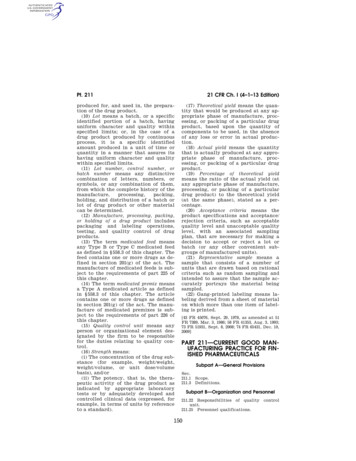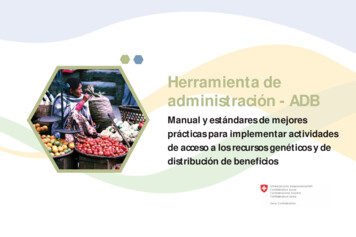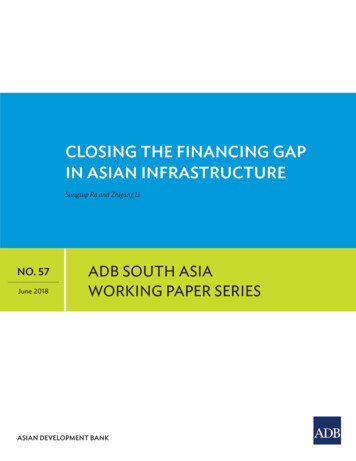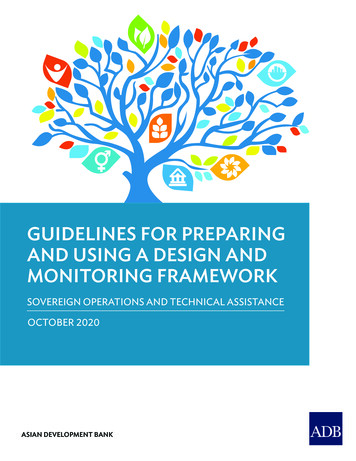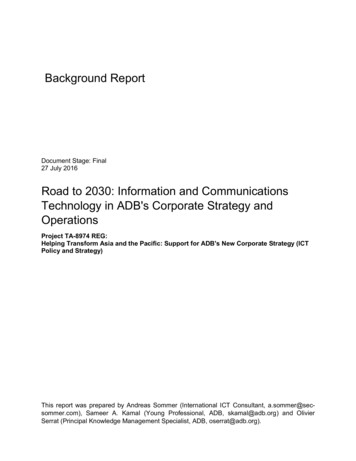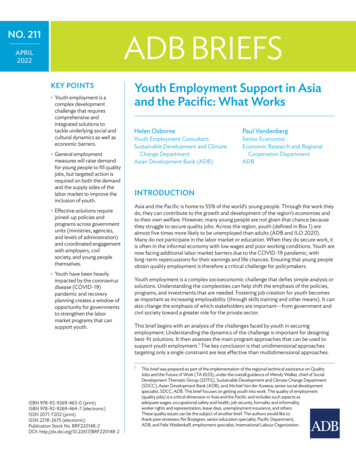
Transcription
ADB BRIEFSNO. 211APRIL2022KEY POINTS Youth employment is acomplex developmentchallenge that requirescomprehensive andintegrated solutions totackle underlying social andcultural dynamics as well aseconomic barriers. General employmentmeasures will raise demandfor young people to fill qualityjobs, but targeted action isrequired on both the demandand the supply sides of thelabor market to improve theinclusion of youth. Effective solutions requirejoined-up policies andprograms across governmentunits (ministries, agencies,and levels of administration)and coordinated engagementwith employers, civilsociety, and young peoplethemselves. Youth have been heavilyimpacted by the coronavirusdisease (COVID-19)pandemic and recoveryplanning creates a window ofopportunity for governmentsto strengthen the labormarket programs that cansupport youth.Youth Employment Support in Asiaand the Pacific: What WorksHelen OsborneYouth Employment ConsultantSustainable Development and ClimateChange DepartmentAsian Development Bank (ADB)Senior EconomistEconomic Research and RegionalCooperation DepartmentADBINTRODUCTIONAsia and the Pacific is home to 55% of the world’s young people. Through the work theydo, they can contribute to the growth and development of the region’s economies andto their own welfare. However, many young people are not given that chance becausethey struggle to secure quality jobs. Across the region, youth (defined in Box 1) arealmost five times more likely to be unemployed than adults (ADB and ILO 2020).Many do not participate in the labor market or education. When they do secure work, itis often in the informal economy with low wages and poor working conditions. Youth arenow facing additional labor market barriers due to the COVID-19 pandemic, withlong-term repercussions for their earnings and life chances. Ensuring that young peopleobtain quality employment is therefore a critical challenge for policymakers.Youth employment is a complex socioeconomic challenge that defies simple analysis orsolutions. Understanding the complexities can help shift the emphasis of the policies,programs, and investments that are needed. Fostering job creation for youth becomesas important as increasing employability (through skills training and other means). It canalso change the emphasis of which stakeholders are important—from government andcivil society toward a greater role for the private sector.This brief begins with an analysis of the challenges faced by youth in securingemployment. Understanding the dynamics of the challenge is important for designingbest-fit solutions. It then assesses the main program approaches that can be used tosupport youth employment.1 The key conclusion is that unidimensional approachestargeting only a single constraint are less effective than multidimensional approaches.1ISBN 978-92-9269-463-0 (print)ISBN 978-92-9269-464-7 (electronic)ISSN 2071-7202 (print)ISSN 2218-2675 (electronic)Publication Stock No. BRF220148-2DOI: http://dx.doi.org/10.22617/BRF220148-2Paul VandenbergThis brief was prepared as part of the implementation of the regional technical assistance on QualityJobs and the Future of Work (TA 6533), under the overall guidance of Wendy Walker, chief of SocialDevelopment Thematic Group (SDTG), Sustainable Development and Climate Change Department(SDCC), Asian Development Bank (ADB), and Michiel Van der Auwera, senior social developmentspecialist, SDCC, ADB. This brief focuses on getting youth into work. The quality of employment(quality jobs) is a critical dimension in Asia and the Pacific and includes such aspects asadequate wages, occupational safety and health, job security, formality and informality,worker rights and representation, leave days, unemployment insurance, and others.These quality issues can be the subject of another brief. The authors would like tothank peer reviewers Per Borjegren, senior education specialist, Pacific Department,ADB, and Felix Weidenkaff, employment specialist, International Labour Organization.
ADB BRIEFS NO. 211Box 1: Definition of YouthGlobally, for statistical purposes, youth are often defined as thoseaged 15–24 years. National definitions vary across the region(e.g., Nepal uses 16–40 years). The Asian Development Bank tendsto define youth internally as those aged 18–29 years. “Youth” is bestunderstood as a stage of transition rather than an age group. This isrelevant to employment as young people make transitions into, outof, and within the labor market in early adulthood, depending onlife opportunities such as education as well as cultural norms andpersonal aspirations. Sources: Authors; International Labour Organization. ILOSTAT(accessed 18 December 2021); World Bank. 2006. World Development Report:Development and the Next Generation.The brief considers policy implications for governments anddevelopment partners. It recommends integrated solutions thatrespond to the complexities of the youth employment experience.Supporting youth in this way is an important part of shaping aninclusive recovery from the pandemic.A COMPLEX DEVELOPMENT CHALLENGEThe youth employment challenge is affected by economic, social,and cultural dimensions and their interconnected dynamics. It isgaining increasing international attention among developmentpartners (see Box 2 for related Sustainable Development Goals).As youth employment remained stubbornly weak after the2008 global financial crisis, there has been increased focus onunderstanding what drives the experience of young people in thelabor market. A key consensus emerged that the root causes ofproblems faced by youth exist on both the supply and demandsides of the labor market. It is not only about young people havinginadequate or irrelevant skills and competencies to be employable,but also about the scarcity of quality jobs for youth.There are five key issues that underpin the complexity of the youthemployment challenge. Understanding these issues can inform thedesign of effective support measures.Youth’s Structural DisadvantageCompared with adults, young people face persistent disadvantagein the labor market (Figure 1). This is evident from key indicators.Taking unemployment first, youth rates tend to be much higherthan for adults. In Asia and the Pacific, 13.8% of young people wereunemployed in 2019, compared with 3.0% of adults, and the youthrate has been hovering at 13% since 2013. As in other regions of theworld, youth unemployment has not recovered to the levels prior tothe global financial crisis, i.e., 11.9% in 2007 (ADB and ILO 2020).In addition, many young people in the region cannot afford to beunemployed. Youth labor market participation in Asia and the Pacificis higher than in other parts of the world. A majority of young peopleare locked in informal employment, working in precarious situations,under poor conditions, and for low pay. Prior to the COVID-19pandemic, 84% of the region’s youth (compared with 69% of adults)had no access to social protection. Extreme or moderate workingpoverty (living on less than 3.20 a day) affected one in four youngworkers, a rate notably higher than the 18% for adults. Further, rates ofyouth not earning or learning have remained persistently high. In 2019,Box 2: Youth and the Sustainable Development GoalsGoal 4. Ensure inclusive and equitable quality education and promotelifelong learning opportunities for all.4.3 By 2030, ensure equal access for all women and men to affordableand quality technical, vocational, and tertiary education, includinguniversity.4.4 By 2030, substantially increase the number of youth and adultswho have relevant skills, including technical and vocational skills,for employment, decent jobs, and entrepreneurship.Goal 4Goal 8. Promote sustained, inclusive and sustainable economic growth,full and productive employment and decent work for all.8.5 By 2030, achieve full and productive employment and decent workfor all women and men, including for young people and persons withdisabilities, and equal pay for work of equal value.8.6 By 2020, substantially reduce the proportion of youth not inemployment, education, or training.8.b By 2020, develop and operationalize a global strategy for youthemployment and implement the Global Jobs Pact of the InternationalLabour Organization.Goal 8 QUALITY EDUCATIONDECENT WORK ANDECONOMIC GROWTHSource: United Nations. Sustainable Development Goals. bledevelopment-goals/.2
Youth Employment Support in Asia and the PacificFigure 1: Youth and Adult Unemployment in Select Economies, 2019Unemployment rate, %302520151050FijiIndiaAdult (25 yrs)IndonesiaKazakhstanMen (15–24 yrs)MalaysiaThailandWomen (15–24 yrs)yrs years of age.Note: Economies selected at random, for illustrative purposes only.Source: International Labour Organization. ILOSTAT Database. https://ilostat.ilo.org(accessed 18 December 2021).there were more than 160 million young people (around a quarterof the region’s youth population) not in employment, education,or training (NEET) and this rate has been on the rise since 2012.Among the world’s subregions, South Asia had the highest NEET ratein 2019, at 30%. For some young people, age combines with othervulnerabilities—including gender, sexual orientation, disability, migrantstatus, and remote or rural location—to compound disadvantage.For instance, young women make up nearly three quarters of NEET inAsia and the Pacific, with many having responsibilities at home for careand/or subsistence production work (ADB and ILO 2020).The Dual Demand–Supply-Side ChallengeThe difficulties youth face in securing quality jobs are caused byconstraints on both sides of the labor market. The employmentchallenge is not only about getting young people into quality jobs(the supply side). It is also about whether sufficient quality jobs areavailable (the demand side). This has been a key insight to emergefrom research and practice in youth employment over recent years.On the supply side, young people are not being well preparedfor the world of work. In South Asia, over half (54%) of the youthpopulation are projected to leave education without the 21st centuryskills required to be employable across 2020–2030. This subregionis expected to have the largest youth labor force in the world until2040 (UNICEF 2019). The persistently high proportion of NEET ofyoung people across Asia and the Pacific indicates the disconnectbetween educational systems and labor markets as well as a lack ofenabling support structures, such as affordable childcare, for youngpeople to work. Japan, the People’s Republic of China, and other Asianeconomies are facing significant talent shortages (Probst and Scharff2019). The problems can be particularly acute when there is a gap in23perceptions of employability between stakeholders in the educationsystem and employers. For example, in Indonesia, while almostall (96%) training institutions believe that their graduates are wellprepared for the job market, only around a third of employers in foodand beverage manufacturing (33%) and the automotive sector (30%)agree (ADB 2021a). It takes time to make education and trainingsystems more responsive to, and even predictive of, job market needs.2As well as possessing inadequate or irrelevant skills to beemployable,3 young people are further disadvantaged by a lack ofjob experience and social capital and by limited information duringjob search (Carranza et al. 2020; ILO 2020). There can also be amismatch between the aspirations of youth on the one hand andthe positions offered by employers on the other, which can lead toanxiety, frustration, and labor market detachment (Gardiner andGoedhuys 2020).While developing the educationalattainment and skills of young workers iskey to progress, unless such supply-sidemeasures are complemented ormatched with demand-side measuresfor job creation, discouragement amongyouth can grow.—ILO 2020See, for example, the discussions at ADB’s event ‘Investing in Education, Skills, and Research Collaborations for Climate Action’ on 10 December on.See, for example, findings from ADB’s annual flagship International Skills Forums: and-skills-development-new.3
ADB BRIEFS NO. 211Even where young people possess appropriate skills andcompetencies, there may not be sufficient jobs available for them.United Nations projections show that more youth will live inAsia than in any other region until around 2080, when it couldbe surpassed by Africa (UN 2015). In Africa, where there is moreresearch attention on youth employment,4 the challenge is beingreframed by some as a “missing jobs crisis” (Fox et al. 2020).This has relevance for the specific contexts of Asia and the Pacific,where lack of quality jobs is a major challenge. While policies andprograms by governments and development partners have typicallyfocused on the supply side, such as skills training (Datta et al. 2018;Goldin et al. 2015), the demand for youth labor is being identifiedincreasingly as the primary constraint.5 Demand-side barriers,such as jobless growth, affect all jobseekers and workers, but mayaffect youth disproportionately. Insufficient creation of entry-leveljobs, restrictive employment regulations, and negative employerperceptions toward youth are key constraints to hiring youngworkers. Further, reduced access to credit, markets, and networksaffects young entrepreneurs (Elder 2014; Baah-Boateng 2016).Youth Vulnerability to ShocksYoung people are more vulnerable than adults to economic crises,and this is so for four main reasons. First, firms reduce new hiring,which disproportionally affects youth, who comprise the majority ofjobseekers. Second, firms are more likely to lay off recent hires, who aretypically young, because they have accumulated less in-work humancapital and exhibit lower productivity. Third, young people are morelikely to work in informal and temporary employment with less accessto protection and support when a crisis strikes (ADB and ILO 2020;ILO 2021a). Fourth, young entrepreneurs have less access to thefinance, resources, information, and networks needed to bolster theirresilience during a crisis (UNDP 2020). At any time, a poor start in theworld of work tends to have long-term repercussions on earnings, jobquality, occupational progression, and well-being. Attempting to enterthe labor market as a young person during a crisis or recession canimpact labor market outcomes for more than a decade and result inlifelong scarring effects (ADB and ILO 2020; ILO 2021a).The COVID-19 pandemic has worsened the precarious situationof youth in Asia and the Pacific. Young people have been affectedon both the supply side (e.g., school closures, reduced training)and the demand side (e.g., firm closures, fewer vacancies).Many young workers in the region are or were employed in sectorshardest hit by the crisis (ADB and ILO 2020; ILO 2021c). Rates ofyouth unemployment, informal employment, and working povertyin the region have or were projected to increase because of the456784pandemic (ADB and ILO 2020). Well-being among youth isalso negatively affected by disruptions to education and work,with young females more likely to suffer than young males(ADB and ILO 2020; Barford, Coutts, and Sahai 2021).As economies recover, the gap in labor market prospects betweenyouth and adults may widen. Analysis of COVID-19 impacts onemployment across 58 countries shows that a youth–adult recoverygap is emerging.6 Recovery of youth employment is either laggingthat of adults or diverging further (ILO 2021a). Notably, labormarket institutions were found to have provided less protectionto youths than adults during the pandemic, based on early globalanalysis of selected high- and middle-income countries.7Youth in the Life CycleThe experience of young people is further complicated bytheir labor force entry during a complex stage of life transition.The term “youth” does not apply to just an age bracket.Youth development is multifaceted, part of a life cycle thatlinks economic and social inclusion and personal growth.The 2007 World Development Report (Development and theNext Generation) was important for establishing youth as a stageof transition with complex development needs. Specifically, thereport identified five youth transitions: learning, work, health,family, and citizenship (World Bank 2006). Economic inclusionshould be part of a holistic experience of social and personalgrowth within a wider context of cultural norms and the politicalenvironment. This understanding has important implications forthe design of youth policies and programs. A review of evidenceon youth employment8 noted:A positive youth trajectory concludeswith the development of a mature adultwho has a positive sense of self, hasdeveloped agency and impulse controland a set of core competencies andskills for engaging effectively with theeconomy, society and the demandsand challenges of everyday life.—Fox et al. 2017See, for example, Kluve et al. 2017.For example, the World Bank and African Development Bank policies have reflected this.For young people, on average, if gross domestic product declines by 10 percentage points, youth employment falls by 8.1% compared to 6.3% for adults.Using selected indicators from the International Labour Organization (ILO)’s EPLex database on national provisions in employment protection, new researchbased on 44 high- and middle-income countries shows that those with more protective labor market regulations in place prior to the COVID-19 pandemicsuffered proportionately fewer job losses compared to those countries with less. However, this association only applies to adults (O’Higgins, Verick, andElsheikhi 2021). https://eplex.ilo.org.The analysis further recognizes that: “A negative trajectory does not develop self-esteem and agency and concludes with risky and/or destructive behavior suchas teen pregnancy, crime and violence, self-destructive health habits, and disengagement from society, all of which can lead to household poverty and lowereconomic growth” (Fox et al. 2017).
Youth Employment Support in Asia and the PacificWithin the youth phase of the life cycle, the work transition isitself complex. The pathways young people take into, out of, andwithin the labor market are increasingly nonlinear. Not only isthe school-to-work transition a challenging time, but more andmore young people also need support during (i) work-to-worktransitions, for example because of tenuous employment relationsinvolving gig-economy jobs and casual contracts; and (ii) workto-study transitions, including part-time study, for upskillingand lifelong learning to support job switching and future careerprogression (NYCA 2020).Youth and the Future of WorkYoung people’s prospects in the labor market are affected by“mega trends” that are shaping the future of work. These trendshave direct bearing on the supply of, and demand for, youthemployment, with COVID-19 accelerating the pace of changein some respects. Three trends are highlighted: demographics,Industry 4.0, and climate change.Demographics, through patterns of fertility and longevity,determine the size of the working-age population and thecohort of young people. Across Asia and the Pacific, there is avaried landscape of demographic transitions. ADB’s Strategy2030 notes:Industry 4.0 is changing tasks within occupations and thereforealso the skills required to perform them. Many young people arestill taught with out-of-date curricula and pedagogy, which meansthey are not well prepared for the demands of a fast-changing labormarket. In Southeast Asia, job creation should be greater thandisplacement in key industries by 2030, creating new opportunitiesfor young workers (ADB 2021a). There is a similar picture globally,with job destruction most likely be offset by growth in the “jobsof tomorrow” (WEF 2020). Furthermore, for many existing jobsthat will remain, the nature of work performed is being changedby technology. Digital transformation has accelerated during thepandemic, with increased use of artificial intelligence, automation,and the virtual office. The gig economy is providing many jobsfor youth and will expand further in the future. Most workersengaged in online and location-based platforms are underthe age of 35 (ILO 2021c). These platforms offer some youngpeople the flexibility and autonomy they prefer, but such workmay also perpetuate mismatches in aspirations and skills whiledistancing young people from quality job conditions and accessto social protection.Climate change may be the trend with the greatest impact on thesocioeconomic prospects of Asia and the Pacific, with implicationsfor youth skills and jobs. The transition to greener economiesbrings a mix of job creation, job substitution, job reduction, andjob transformation. It can create significant fragility in people’slivelihoods, especially those in vulnerable and marginalizedcommunities at risk of climate-induced shocks. Climate changemay generate over 100 million jobs globally by 2030, but close to80 million jobs could also be lost (UN 2021). Anticipating thesechanges has particular relevance for students, young jobseekers,and young workers, given that “young people generally tend tohave stronger aspirations for work that benefits society, in thiscase by contributing to environmental sustainability” (Chacaltaand Dasgupta 2021). As governments “build back better”from the pandemic, youth may benefit from employment andentrepreneurship opportunities through green growth and greenjobs, particularly in renewable energy and sustainable tourism9(Chacalta and Dasgupta 2021).There are over 2 billion individuals underthe age of 30 living in Asia and the Pacific,representing 54% of the global youthpopulation. Favorable demographicsor demographic dividends are oftencorrelated with strong economicdevelopment and social progress, but thisis contingent on the ability of developingmember countries to offer quality jobsCOMPREHENSIVE ANDand maximize workers’ productivity.—ADB 2018The age distribution of the population (current and projected) setsthe basis for the policies that can unlock the productive capacity ofworking-age people. Economies in East Asia, including the People’sRepublic of China and the Republic of Korea, have been able toreduce substantially their dependency ratio (i.e., nonworking-ageto working-age population) while maintaining growth in grossdomestic product and average wages alongside lower youthunemployment rates (World Bank 2012).9INTEGRATED SOLUTIONSThe preceding section showed that young people face complexrealities and multiple constraints in their experience of securingemployment. Policies and programs to support youth employmentare evolving in response to a better understanding of themultifaceted and complex challenge. It is recognized that raisingaggregate demand is the best way to increase job opportunities forall workers. Yet, a rising tide does not lift all boats. Young peopleget left behind; particularly vulnerable youth who experience otherdrivers of disadvantage including location (urban, rural, remote),UN Global Initiative on Decent Jobs for Youth Thematic Plan 4. Green Jobs for Youth. df.5
ADB BRIEFS NO. 211disabilities, gender, and informality. Targeted youth measures arerequired and work best when they are part of a multidimensionalapproach that combines supply-side, demand-side, andintermediation interventions. This section discusses the main typesof youth employment support, with insights about how they arebest delivered. It then highlights features of effective integratedapproaches, providing examples of leading programs from theregion and elsewhere.a future-ready workforce, young people should be trained intechnical, digital, and soft skills, with the latter including workplacevalues, self-respect, and communication. Instruction is delivered inthe classroom, online, or on the job. Focusing on what employersvalue increases effectiveness and can be achieved throughworkplace exposure (Almeida, Behrman, and Robalino 2012).Quality apprenticeships and internships, as well as greater privatesector input into the curriculum, can enhance job-specific skills andease the school-to-work transition (Generation Unlimited 2020).Types of Youth Employment SupportEvaluations are ongoing to learn more about the content and lengthof training that is effective for different types of youth. Tailoredprovision works best, recognizing the specific constraints faced byindividual youth. Incentive-based payments for training providers totarget marginalized youth and strong profiling mechanisms are highlyeffective features of training programs (Datta et al. 2018). Traininginitiatives that enable workers to move into in-demand sectors areamong the most successful. They help overcome key sectoral orspatial mismatches in the labor market (McKenzie 2017). Finally,in the entrepreneurship field, there is a new wave of alternativetraining programs that are not limited to traditional business areassuch as accounting, marketing, and human resource management.The new wave incorporates the use of psychology and heuristics,is sensitive to gender, provides assistance from peers and mentors,and customizes practices to the local context. These approaches arefound to improve business success (McKenzie 2020).10The main types of youth employment support are categorizedin Figure 2. They are best delivered in combination with oneanother and tailored to context. Context spans social, economic,cultural, and political environments and links with the individualcircumstances of the young person.Supply-Side InterventionsDeveloping Youth Human Capital: Skills Training. Skillstraining has been the most common type of youth employmentprogram. Training programs improve employment and earningsof youth, with larger effects in low- and middle-incomeeconomies than high-income ones. Results are greatestwhen training is combined with other types of support.The combination of skills training and entrepreneurshippromotion can work well where job opportunities in the formalsector are scarce (Kluve et al. 2017).Types of skills training and delivery modalities have been evolvingrapidly in response to employer needs and skills gaps. To developIncreasing Youth Access to Wage Employment: WageSubsidies. Wage subsidies can increase the hiring of young workers.The transfers can be to the employer (to reduce wage costs) orto the employee (to increase income from working). InitiativesFigure 2: Main Types of Youth Employment SupportSupply-sideSkills training(techical, soft,and digital)Career pathwayscounselingSubsidizedemployment(wage subsidiesand publicemployment)Source: Authors.106There is significant heterogeneity in upportJobpreparation,search andmatchingYouth inclusionin general macroand firm labormarket measuresJob creation inyouth dominantsectors
Youth Employment Support in Asia and the Pacificthat reduce both the employer’s social security contribution andwage costs (through a subsidy) can have a large positive impact onemployment. Subsidies work best when a young person gains formalemployment experience and acquires on-the-job knowledge andskills that increase their productivity and therefore employability.In addition, information asymmetries are reduced as employerand employee get to know each other, which can lead to a longterm job offer. Subsidies are particularly relevant for youth whose(perceived) marginal productivity may be below market wages.Providing subsidies to employers can incentivize more job searchamong youth, because the latter believe there is more opportunityto find work. Employee-side subsidies can be used to better targetspecific disadvantaged groups (Kluve et al. 2017).PEPs provide income generation for eligible households, oftenwhen revenue alternatives are scarce. Improved food securityand increased consumption can bring wider benefits to localcommunity development. Through job-ready skills acquisition,PEPs can also play an important part in mitigating human capitaldepreciation when individuals are detached from the labor market.Other gains for the youth include reductions in antisocial behaviorand increases in social integration. For a multilateral developmentbank, public employment programs can be integrated intoinfrastructure projects, community works, and social developmentschemes. When the impacts of improved market functioning orquality of life from enhanced assets and services are accounted for,the benefits of PEPs can be wide-ranging.Effects of wage subsidies are typically short-term and do notlast much beyond the subsidy period (Datta et al. 2018). On thisbasis, they are best paired with additional training, which can beprovided through apprenticeship schemes (Kluve et al. 2017).Combining wage subsidies with job-matching services can alsoimprove outcomes (Goldin et al. 2015). Impacts of wage subsidiescan be limited if the target youth would have been hired anyway(deadweight) or if noneligible workers are laid off or overlookedin favor of targeted young workers (substitution). Conditionalitiesfor employers are important to ensure intended behavior, e.g.,to prevent firms churning their workers to exploit access tofinancial assistance (Bördős, Csillag, and Scharle 2016). Therecan also be issues with stigma: firms may avoid hiring eligibleyouth because of perceptions of low productivity; or vulnerableyouth may find eligibility degrading and avoid participation.Take-up among employers of subsidy schemes can be improvedby wide dissemination of the benefits and efficient administrativeprocedures (Generation Unlimited 2020).There
is expected to have the largest youth labor force in the world until 2040 (UNICEF 2019). The persistently high proportion of NEET of young people across Asia and the Pacific indicates the disconnect between educational systems and labor markets as well as a lack of enabling support structures, such as affordable childcare, for young people to work.
